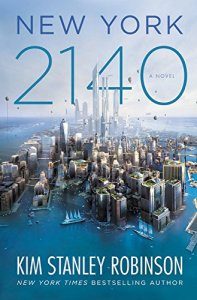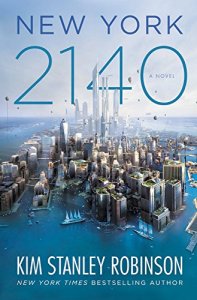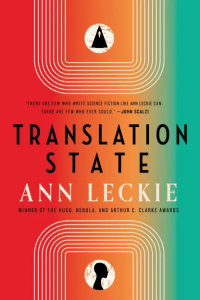Gary K. Wolfe reviews Kim Stanley Robinson
New York 2140, Kim Stanley Robinson (Orbit 978-0316262347, $28.00, 640pp, hc) March 2017.
 It’s been just a decade since Kim Stanley Robinson published Sixty Days and Counting, the final volume in his Science in the Capital trilogy (since updated in the one-volume version Green Earth), and during that time SF’s common approach to global warming seems to have shifted from cautionary tales to a general acceptance of drowned or disappeared coastal cities as a default consensus future. This could represent a larger shift in attitude than it at first seems. Whereas earlier default futures involved such things as moon colonies or sophisticated AIs, the tone was generally aspirational; even when global disaster back on Earth counterpointed the growth of space colonies (as in Robinson’s own Mars trilogy or 2312 – or, for that matter, going all the way back to Bradbury’s The Martian Chronicles), there was always a viable path to a future somewhere else. Not that Robinson’s new novel New York 2140 lacks such a path, or lacks aspirational characters, but the aspirations no longer involve evading disaster so much as climbing up from the muck, of finding a way to have a nice breakfast in the ruins.
It’s been just a decade since Kim Stanley Robinson published Sixty Days and Counting, the final volume in his Science in the Capital trilogy (since updated in the one-volume version Green Earth), and during that time SF’s common approach to global warming seems to have shifted from cautionary tales to a general acceptance of drowned or disappeared coastal cities as a default consensus future. This could represent a larger shift in attitude than it at first seems. Whereas earlier default futures involved such things as moon colonies or sophisticated AIs, the tone was generally aspirational; even when global disaster back on Earth counterpointed the growth of space colonies (as in Robinson’s own Mars trilogy or 2312 – or, for that matter, going all the way back to Bradbury’s The Martian Chronicles), there was always a viable path to a future somewhere else. Not that Robinson’s new novel New York 2140 lacks such a path, or lacks aspirational characters, but the aspirations no longer involve evading disaster so much as climbing up from the muck, of finding a way to have a nice breakfast in the ruins.
There’s plenty of actual muck in New York 2140. Two of Robinson’s most engaging characters, the orphans Stefan and Roberto, are what an earlier generation would have called mudlarks, scrounging a living by diving in the hazardous canals that have replaced the streets of an inundated lower Manhattan. Another character, Vlade, is a building engineer at the old Met Life tower on Madison Square – the central focus of the action – who spends a fair amount of his time trying to shore up the now-submerged parts of the building and whose ex-wife Idelba operates a dredging barge for salvage operations. Yet another figure, Mr. Hexter, is an old book and map collector living in a condemned building constantly in danger of simply sinking into the muck. As such colorful and eccentric characters might suggest, a good portion of New York 2140 has an oddly Dickensian feel to it, despite such futuristic trappings as 300-story ‘‘superscrapers’’ and personal airships piloted by AIs.
In fact, in contrast to the Dos Passos expansiveness of 2312 and despite its panoramic title, New York 2140 is a comparatively intimate tale of a handful of representative characters whose paths cross in various ways in a New York defiantly rebuilding after two separate ‘‘pulses’’ have left sea levels something like 50 feet higher than they are now. There are still quite a few stylistic fillips: pithy interchapter quotations on New York life, background information filled in by a wise-ass unnamed narrator simply called ‘‘the citizen,’’ and a playful delight in allusive coinages like ‘‘pynchonpoetry,’’ ‘‘calvinocity,’’ ‘‘pikettied,’’ ‘‘amphibiguity,’’ and ‘‘gehryglory.’’ But the novel is driven by that fascinating cast, including (in addition to those already mentioned) an imposing African-American police inspector with the oddly Nordic name Gen Octaviasdottir (which sounds like it could be a tribute to a great SF writer); an immigrant and refugee worker named Charlotte Armstrong (another literary name, if likely a coincidence); a self-satisfied financial consultant named Franklin Garr, who’s figured out how to make a fortune speculating on ‘‘intertidal’’ real estate (and who is the only first-person narrator other than the unnamed ‘‘citizen’’); an ecology worker and Internet celebrity named Amelia Black, who is using her personal airship Assisted Migration to try to relocate surviving polar bears to Antarctica (and who provides the novel’s most surreally comic moment when the bears get loose in the airship); and two freelance coders nicknamed Mutt and Jeff (yet another literary allusion of sorts), who find themselves kidnapped and imprisoned after one of them releases a series of codes designed, basically, to correct and rationalize the whole capitalist financial system. All are linked in some way to the Met Life tower, a particularly iconic choice of setting since its original design was meant to reflect the campanile in Venice, and since it now serves as a refuge in the ‘‘SuperVenice’’ that New York has become.
The plot initially develops along four lines: the disappearance of Mutt and Jeff, who had been camping in a pre-fab ‘‘hotello’’ on a terrace of the Met Life tower, a mysteriously generous offer from an anonymous source to buy the entire building, Stefan and Roberto’s efforts to uncover a fortune in gold coins from a real-life 18th-century British shipwreck whose location had been determined by Mr. Hexter’s indefatigable map research, and Amelia’s efforts to rescue the polar bears (though this is a distinctly secondary narrative line barely related to New York). As these stories begin to converge, a storm of historic proportions – something of a Robinson specialty by now, recalling the superstorms that bookended Forty Signs of Rain – descends on New York, ironically setting the stage for a climax which reflects Robinson’s characteristically cautious optimism – although another climax of sorts tries to resolve some of the more complex issues of capitalism, economics, and public policy that have shaped the ‘‘citizen’s’’ chapters, as well as the debates between the financier Franklin and the social worker Charlotte (who eventually decides to enter politics). In fact, the novel at times becomes such a tribute to the resilience and ingenuity of New Yorkers that the drowned Manhattan seems more intriguing than frightening, and a pretty attractive place to explore; as our anonymous citizen says at one point, ‘‘Possibly New York had never yet been this interesting, which is saying a lot, even discounting all the bullshit.’’ Likewise, there have been more than a few environmental catastrophe tales set in a future New York, but possibly none of them have been this interesting.






